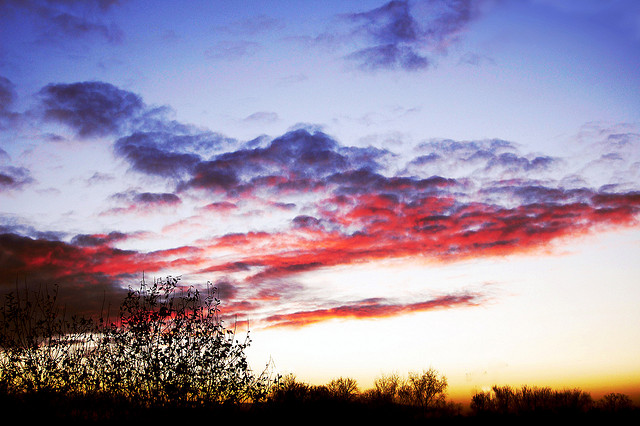Predicting Weather the Natural Way
“Red sky at night, sailor’s delight. Red sky in morning, sailor’s warning”
That is just one of many old weather folklore. I’m sure we’ve all heard some type of crazy way to predict incoming weather. Surprisingly though, many of them are accurate. So, if you forgot to check the weather report before heading out on that hike or fishing trip, don’t fret, there are other methods for predicting weather. Although you really should have checked the weather reports!
Let’s start with the clouds. Clouds are, by far, the best weather indicators and anyone who spends time participating in outdoor activities should learn “cloud reading.”
There are 10 basic types of clouds you need to know:
Cirrus
• high altitude cloud• thin and wispy• usually indicates changing weather
Cirrocumulus
• high altitude cloud• dappled or rippled appearance• indicates good weather UNLESS they appear with Cirrus clouds, then rain is on the way
Cirrostratus
• high altitude cloud• relatively transparent• usually indicates changing weather• causes a circle to appear around the moon
“A Ring Around the Moon, Rain or Snow Is Coming Soon”
Altocumulus
• middle altitude cloud• appear AFTER a storm
Altostratus
• middle altitude cloud• appears as a greyish veil over the sun or moon• when darkens, signifies incoming rain
Stratocumulus
• low altitude cloud• appears as a lumpy layer of clouds• sometimes accompanied by weak intensity precipitation
Stratus
• low altitude cloud that• resembles fog and• although no precipitation falls they sometimes produce a drizzle
Nimbostratus
• low altitude cloud• dark, grey, wet looking cloudy layer• indicate rain or snow
Cumulus
• low altitude cloud• large “fluffy” cotton like clouds• signify a storm IF they flatten and turn gray
Cumulonmbus
• low altitude cloud that extend upward towards higher altitudes• mountainous, flat bottomed dark base• capable of producing lightning, hail and occasional tornadoes
For a great image of the different cloud types click HERE
Aside from clouds, nature has many other ways of letting us know when rain is coming. Various plants will open their pores and release a “musty” order due to impending rain. At the same time, some plants, such as: shamrock, morning glory, chicory and the clover, will close their petals or leaves because of incoming rain.
Pine cones are another great indicator of weather changes. Pine cones open and close depending on the humidity to help seed dispersal. Dry weather causes the pine cone to open up so the wind can catch the seeds and allow them to be dispersed in the air far away from the original tree. When the humidity rises and rain is likely, the pine cone closes up to prevent the seeds escaping. So keep an eye on the pine cones!
Birds and bees can also tell us what’s going on with the weather. Bees tend to fly back to their hives during the day when rain is due. It is also believed that birds will fly lower due to barometric pressure drops.
To determine the temperature, count the number of times a cricket chirps in 14 seconds and add 40 to that number and you will have an approximate temperature in Fahrenheit.
We’ve all heard the one about arthritis acting up when rain is coming. I can honestly say, yes, this is true. I have rheumatoid arthritis and I do notice added discomfort when it rains. I’ve also heard that recently healed broken bones and teeth also have a tendency to create discomfort when rain is coming.
“Rainbows in the Morning Give You Fair Warning”
An early morning rainbow in the west rainbow in the west is a result of the sunlight from the east striking moisture. This moisture usually indicates an impending storm.
Another crazy way to supposedly predict weather is from a cup of coffee! I’ve never tried this so I have no idea if it works. Supposedly, if the bubbles in your coffee quickly move to the edge, than good weather is on the way. If the bubbles stay in the center, then clouds and rain are on the way. If you’re familiar with this method, please comment below and let us know if and how well this works.
So, if you didn’t check the weather reports before you left for that outdoor excursion, and you really should have, at least you can think back to some of the natural indicators above and hopefully avoid being trapped in a storm. I’m sure there are many other natural ways to predict weather that I wasn’t able to cover, so feel free and leave it in the comments.
Thanks, Dayna
Reference: http://ww2010.atmos.uiuc.edu/(Gh)/guides/mtr/cld/cldtyp/home.rxml
http://weather.aol.com/2012/08/16/20-surprising-ways-to-predict-the-weather
Photo by Duncan used with permission

















